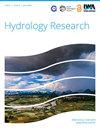中国西部典型冰川盆地基于冰川水服务视角的流域水政策
IF 2.6
4区 环境科学与生态学
Q2 WATER RESOURCES
引用次数: 0
摘要
以长江源流域(YRSB)和疏勒河流域(SRB)为典型案例,利用可持续发展目标 6.4.2 中的水资源压力水平(LWS)对两流域水资源的可持续性进行了评价,并量化了冰川径流对 LWS 的调节作用。从 2000 年到 2030 年,雅鲁藏布江流域的社会经济发展水平较低,用水总量仅约为 0.18×108 m3,而石羊河流域的社会经济发展水平相对较高,用水总量约为 10×108 m3,是雅鲁藏布江流域的 50 倍。由于上述原因,石羊河流域的长水资源量远高于长沙湾,导致水资源的可持续性很低。作为自然资产,冰川以径流方式流向下游,因此应考虑在流域范围内进行补偿。在流域内,需要对水资源进行优化配置。在流域间尺度上,需要完善冰川水资源补偿机制。本文章由计算机程序翻译,如有差异,请以英文原文为准。
Watershed water policy based on a glacier water service perspective in the typical glacier basins, Western China
Taking the Yangtze River Source Basin (YRSB) and Shule River Basin (SRB) as two typical cases, the sustainability of the water resources in these two basins was evaluated using the level of water stress (LWS) from sustainable development goal 6.4.2, and the regulating effect of the glacier runoff on the LWS was quantified. From 2000 to 2030, the level of socioeconomic development in the YRSB is low, and the total water consumption is only about 0.18 × 108 m3, whereas the SRB has a relatively high level of socioeconomic development and total water consumption is about 10 × 108 m3, i.e., 50 times higher than that in the YRSB. For the aforementioned reasons, the SRB's LWS is much higher than the YRSB's, resulting in a very low sustainability of water resources. As natural assets, glaciers flow downstream in the runoff mode, so compensation at the watershed scale should be considered. In the basin, the optimal allocation of water resources is needed. At the inter-basin scale, the compensation mechanism of glacier water resources needs to be improved.
求助全文
通过发布文献求助,成功后即可免费获取论文全文。
去求助
来源期刊

Hydrology Research
WATER RESOURCES-
CiteScore
5.00
自引率
7.40%
发文量
0
审稿时长
3.8 months
期刊介绍:
Hydrology Research provides international coverage on all aspects of hydrology in its widest sense, and welcomes the submission of papers from across the subject. While emphasis is placed on studies of the hydrological cycle, the Journal also covers the physics and chemistry of water. Hydrology Research is intended to be a link between basic hydrological research and the practical application of scientific results within the broad field of water management.
 求助内容:
求助内容: 应助结果提醒方式:
应助结果提醒方式:


